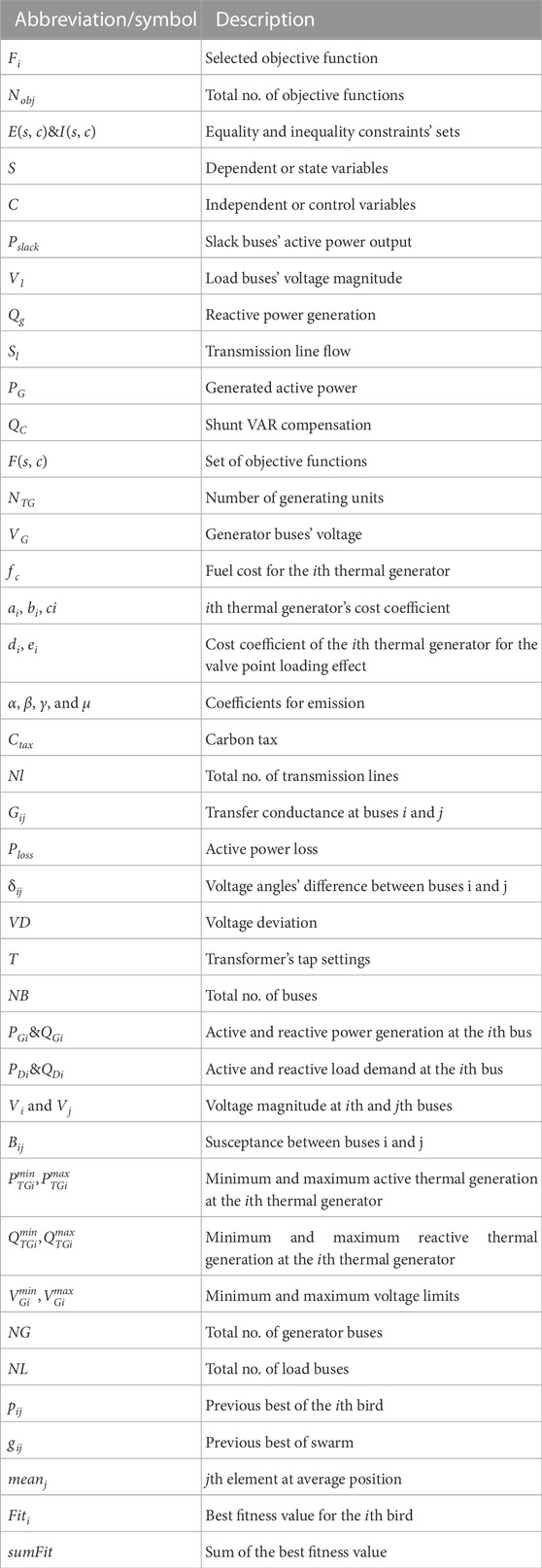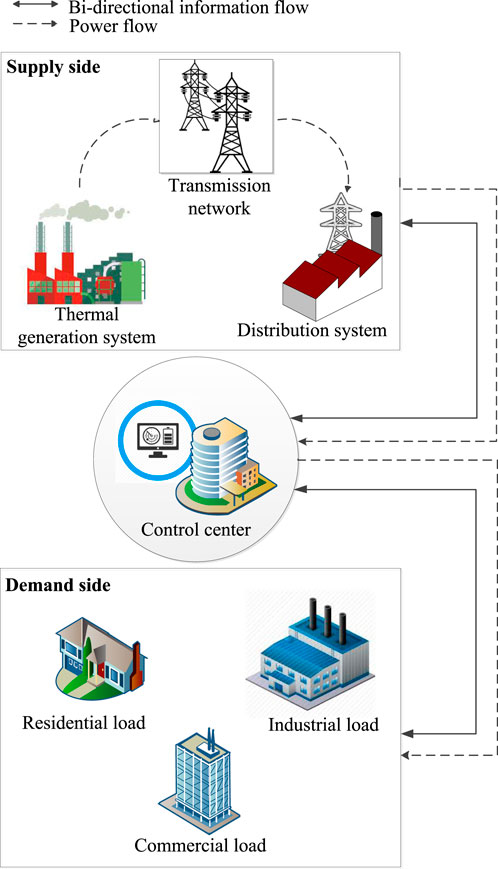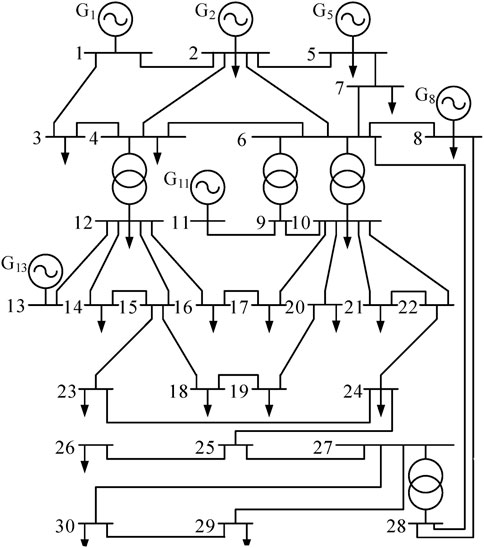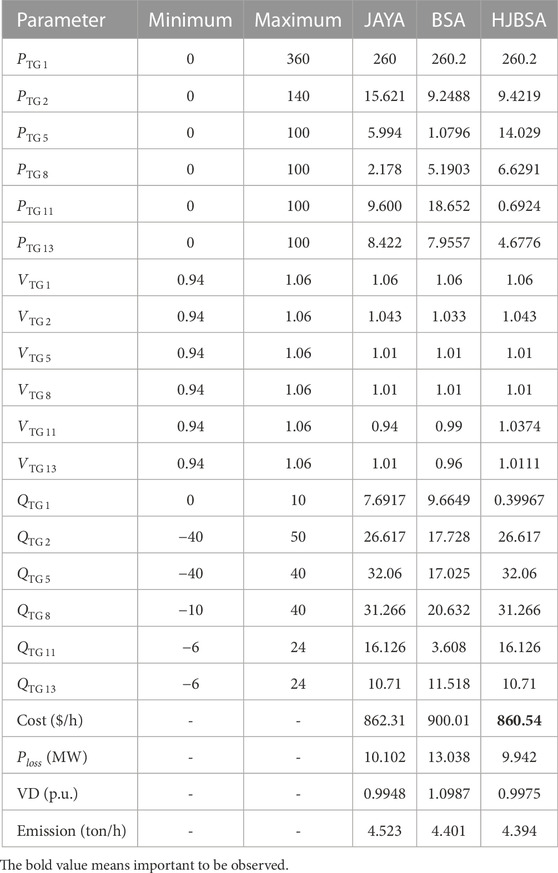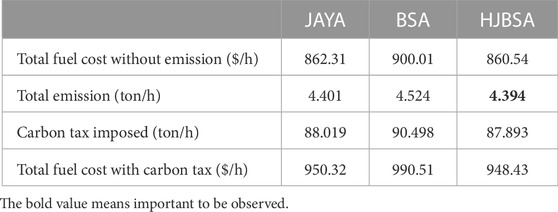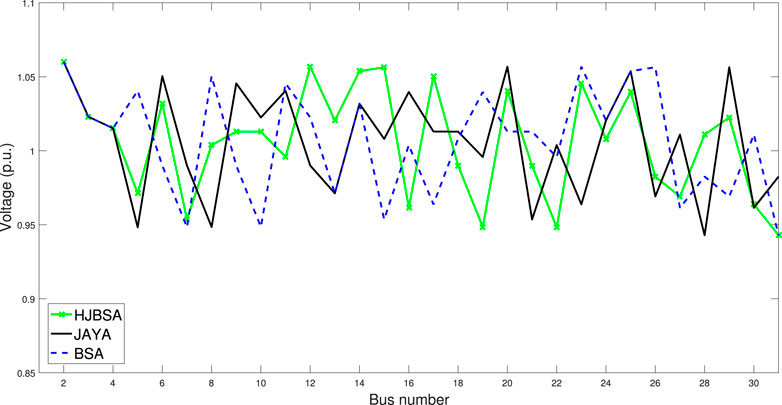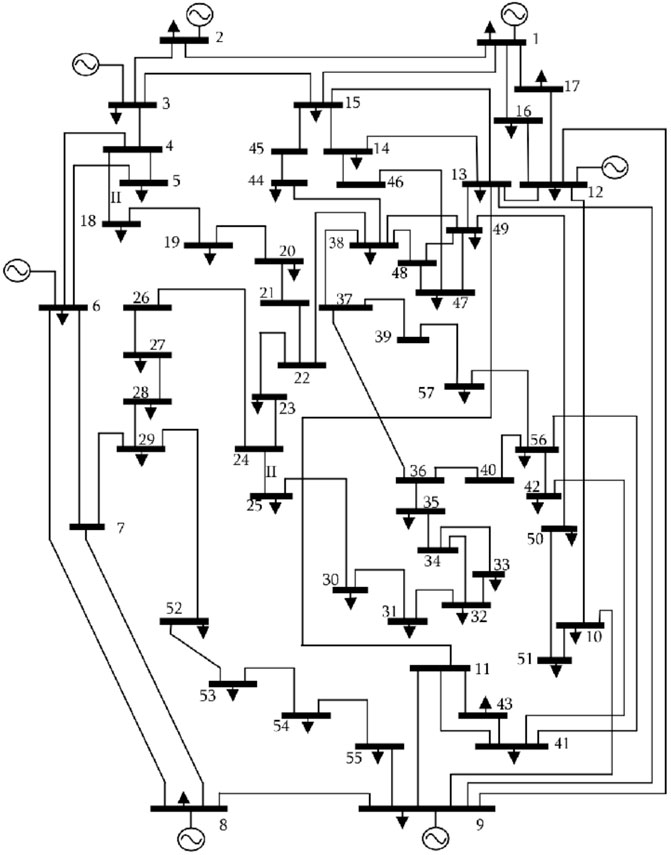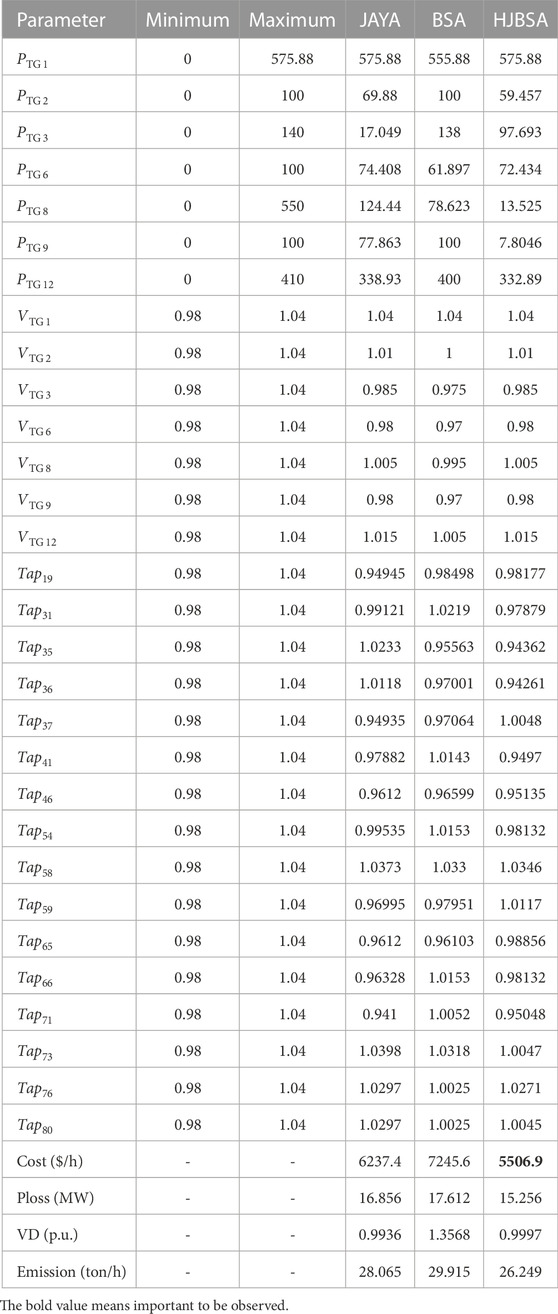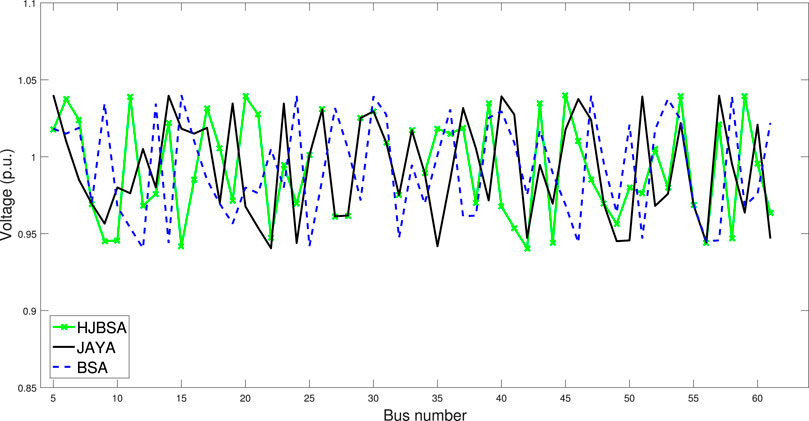- 1Department of Computer Engineering, College of Computer and Information Sciences, King Saud University, Riyadh, Saudi Arabia
- 2Department of Computer Science, COMSATS University Islamabad, Islamabad, Pakistan
- 3Institute of Innovation, Science and Sustainability, Federation University, Brisbane, VIC, Australia
Financial loss in power systems is an emerging problem that needs to be resolved. To tackle the mentioned problem, energy generated from various generation sources in the power network needs proper scheduling. In order to determine the best settings for the control variables, this study formulates and solves an optimal power flow (OPF) problem. In the proposed work, the bird swarm algorithm (BSA), JAYA, and a hybrid of both algorithms, termed as HJBSA, are used for obtaining the settings of optimum variables. We perform simulations by considering the constraints of voltage stability and line capacity, and generated reactive and active power. In addition, the used algorithms solve the problem of OPF and minimize carbon emission generated from thermal systems, fuel cost, voltage deviations, and losses in generation of active power. The suggested approach is evaluated by putting it into use on two separate IEEE testing systems, one with 30 buses and the other with 57 buses. The simulation results show that for the 30-bus system, the minimization in cost by HJBSA, JAYA, and BSA is 860.54 $/h, 862.31, $/h and 900.01 $/h, respectively, while for the 57-bus system, it is 5506.9 $/h, 6237.4, $/h and 7245.6 $/h for HJBSA, JAYA, and BSA, respectively. Similarly, for the 30-bus system, the power loss by HJBSA, JAYA, and BSA is 9.542 MW, 10.102 MW, and 11.427 MW, respectively, while for the 57-bus system, the value of power loss is 13.473 MW, 20.552, MW and 18.638 MW for HJBSA, JAYA, and BSA, respectively. Moreover, HJBSA, JAYA, and BSA cause reduction in carbon emissions by 4.394 ton/h, 4.524, ton/h and 4.401 ton/h, respectively, with the 30-bus system. With the 57-bus system, HJBSA, JAYA, and BSA cause reduction in carbon emissions by 26.429 ton/h, 27.014, ton/h and 28.568 ton/h, respectively. The results show the outperformance of HJBSA.
1 Introduction
Satisfying load demand in an economical and efficient manner and carrying out optimal system’s operations are the basic functions of power systems (Warid et al., 2018) along with optimal power flow (OPF). Divisioning of the power systems is carried out in two parts: the demand side and supply side. The demand side consists of the demand load from industrial, commercial, and residential areas, while the supply side comprises distribution, transmission, and generation systems. The supply side faces sustainability, reliability, and maintenance issues due to the increase in electricity demand (Khalid et al., 2018; Safaie et al., 2022). At the moment, the power system domain’s OPF challenges are receiving a lot of attention. It is because the power systems are highly constrained, large-scale, complex, and face non-linear and concave optimization problems (Shehab et al., 2020). The best operating levels for the power systems are determined by OPF in order to satisfy the energy demand of users (Optimal Power Flow—NEOS, 2022; Pandya, 2022; Wang and Abdalla, 2022). In transmission networks, the OPF problems are solved and formulated to efficiently provide energy at a low operational cost. In general, the performance objectives used for solving the OPF problems include voltage profile improvement, carbon emission and fuel cost minimization, and power loss reduction. However, the system’s generation capacity, bus voltage, and line capacity constraints are not considered (Biswas et al., 2019; Liu et al., 2022).
The OPF problem has been solved using a variety of methods over many years. In Skolfield and Escobedo (2021), the first and the simplest algorithm for solving OPF problems is presented. Later on, solutions proposed using different conventional optimization techniques, i.e., linear programming, semi-definite programming, interior point method, Lagrangian relaxation, and reduced gradient method in Chen et al. (2020); El-Fergany and Hasanien (2020); Li et al. (2020); Abd El-sattar et al. (2021); Castro et al. (2022); Chen et al. (2022), are used for solving OPF problems. However, the methods do not obtain optimal solutions as a result of the non-linear features of their objective functions. Furthermore, high computational and execution times increase the conventional methods’ complexity. Thus, resolving the problems becomes imperative using optimization methods, which are scalable and can solve the complex OPF problems.
There exist various optimization problems that differ in their nature. Among the problems, some are discrete or continuous in nature, while others are convex, non-convex, linear, or non-linear. It is easy to find a solution for continuous optimization problems using the conventional or traditional methods like gradient-based methods. On the contrary, if a problem is complex or non-convex, it is hard to determine its optimal solution when using the traditional methods. For this purpose, nature-based heuristic and meta-heuristic techniques are proposed as solutions for solving the complex optimization problems in minimum execution time. Population-based heuristic algorithms are used for various optimization purposes. These algorithms are categorized as evolutionary algorithms and swarm intelligence algorithms. All of these algorithms need some control parameters like the number of generations and size of population to be executed. These general purpose algorithms, such as the gray wolf optimizer (GWO), binary particle swarm optimization (PSO), wind-driven optimization (WDO), and genetic algorithm (GA), are efficiently used in Iqbal et al. (2018) for optimization of an energy management system. In Khalid et al. (2018), GA and bacteria foraging optimization (BFO) are applied for efficient energy optimization in smart buildings. For intelligent load management in smart homes, binary PSO, GA, and the cuckoo search algorithm (CSA) are used by Javaid et al. (2017a). However, GA, WDO, and the harmony search algorithm (HSA) are implemented for optimizing an energy management controller in Hussain et al. (2018).
Various evolutionary and population-based heuristic methods are utilized for determining optimized solutions to OPF problems. For the purpose of resolving OPF issues in large-scale energy systems, the authors in El-Fergany and Hasanien (2018) suggest a novel approach based on a tree-seed algorithm (TSA). In the study, the offered power system experiences less actual power loss, overall voltage variation, and overall fuel cost. The authors in Biswas et al. (2019) addressed the OPF problems where the intermittent renewable power sources are modeled via probability density function (PDF). Reductions in electricity cost and carbon emission are the objective functions along with reserve and penalty costs because of under- and over-estimations of the renewable energy resources (RERs). To solve the optimization problems, a successful history-based adaptation technique for differential evolution (SHADE) technique is utilized. In Banerjee et al. (2022), an optimization model is proposed using a backtracking search optimization (BSO) technique. The model considers six different study cases to overcome the issues of voltage instability, carbon emission, and high fuel cost. The results obtained from simulations show that there exists a trade-off between voltage profile improvement, carbon emission, and electricity cost. Table 1 shows nomenclature.
The authors in Mohagheghi et al. (2018) perform real-time and day-ahead OPF by considering operational intervals between 5 min and 15 min. RERs are incorporated in the electricity generation systems. In addition, the scheduling of generation resources is performed. However, the valve point loading effect and carbon emission factor are ignored. The proposed work’s major contributions are enlisted.
• The OPF problem is solved to obtain the settings of optimum control variables.
• The bird swarm algorithm (BSA), JAYA, and a hybrid of both algorithms, termed as the hybrid JAYA bird swarm algorithm (HJBSA), are used for obtaining the settings of the optimum variables.
• The proposed algorithm, HJBSA, minimizes carbon emissions generated from thermal systems, fuel cost, voltage deviations, and losses in the generation of active power.
• The proposed solution is assessed on two different IEEE testing systems: one comprising 30 buses and the other comprising 57 buses.
• The suggested algorithm is superior to the existing algorithms in terms of lowering carbon emissions, fuel costs, voltage variations, and power losses, according to the performed simulations.
The remaining manuscript is structured in the following manner. In Section 2, related work is presented, while OPF problems’ formulation along with their constraints are given in Section 3. Section 4 provides the algorithms’ specifics. The results of the simulations are reported in Section 5, while the conclusions and plans for further research are offered in Section 6.
2 Related work
In recent years, extensive work has been carried out for controlling the power flow in a power generation system. In addition, numerous optimization algorithms and other traditional techniques are utilized for obtaining the optimal solutions. Different algorithms, like PSO, WDO, GWO, and BFO, have been used in the literature to deal with the OPF issue. These all are state-of-the-art methods. However, they have various issues like algorithmic complexity and convergence sensitivity. Moreover, OPF is a highly non-linear and multimodal optimization problem. Thus, it is not handled efficiently via local optimization techniques.
Moving ahead, constrained OPF problems are solved using a simplex-based chaotic PSO (SCPSO) scheme for preventing PSO from early convergence (Chopra et al., 2021). The minimization of operational cost, enhancement of bus voltage profiles, and reduction of energy loss by focusing on the effects of the valve point load are the major objectives of the proposed scheme. The proposed scheme is evaluated upon IEEE 26-bus and 57-bus systems. After comparison of the proposed scheme with the existing schemes, it is found better than the existing schemes in terms of convergence rate. For solving OPF problems, a gravitational search algorithm (GSA) is implemented in Shilaja and Arunprasath (2019), which is modeled as concave optimization problems with inequality and equality constraints. The stated objectives of this study are similar to the general OPF problems. The GSA technique is used upon IEEE systems having 30 and 57 buses for obtaining the best control variables’ settings with both reduced energy cost and minimized power loss.
Other than heuristic and meta-heuristic approaches, the fuzzy logic approach is also used with the combination of different techniques to get the optimized settings for the OPF problem. The problem is formulated and solved by integrating the fuzzy technique with GA and PSO (Khan et al., 2020). Control variables are shifted to achieve the minimized cost and reduced energy loss with an improved voltage profile. The outcomes of the simulations demonstrate the reliability and efficacy of the proposed solution. In Ebeed et al. (2018), adaptive fuzzy logic controllers are implemented for the optimal dispatch of generated reactive power. This solution is implemented using the IEEE training system comprising 30 buses. The proposed solution’s results are compared with the results of static fuzzy logic controllers. The system is proved to be a useful operator for optimizing the control variables’ values. Mathematical modeling is proposed for solving multi-objective OPF problems using GA integrated with fuzzy decisions (Chen et al., 2019). The proposed model is tested upon a 59-bus system from the Algerian electrical network to attain the objectives of generation cost minimization, emission reduction, and improvement in the voltage profile index. This optimization problem is solved for three different scenarios, and the evaluated results depict a trade-off between environmental dispatch and voltage constraints.
Akbari et al. (2021) used a teacher–learner-based optimization (TLBO) method for finding the best solution in solving multi-objective OPF problems after satisfying the constraints of the system. To improve the rate of convergence, the basic TLBO algorithm is combined with quasi-opposition-based learning (QOBL) technique. The methodology is applied on an Indian utility that has 62 buses and also on IEEE systems having 30 and 118 buses. To show the robustness of the combined quasi-oppositional teaching–learning-based optimization (QOTLBO) scheme, different objectives are formulated and solved. Their results verify that QOTLBO is better than benchmark schemes in terms of finding the best solutions. Pravina et al. (2021) proposed an adaptive real-coded biogeography-based optimization (ARCBBO). The proposed technique outperforms the existing techniques in terms of fulfilling the physical and operational constraints. Similarly, an improved ABC (IABC) technique is utilized for solving the fuzzy multi-objective OPF problems (He et al., 2015). The objectives to be attained are the same as the basic objectives for OPF, which are cost and emission reductions, power loss minimization, and voltage deviation enhancement. IABC is implemented and tested upon IEEE systems having 30, 57, and 300 buses. Single and multi-objective OPF problems are solved using differential evolution (DE) and GWO techniques by keeping in view the system constraints (El-Fergany and Hasanien, 2015). To solve multi-objective problems, a fuzzy-based Pareto front technique is integrated into the system. IEEE testing systems comprising 30 buses and 118 buses are utilized. The adjustment of the control variables depicts that the proposed technique is better than the existing methods.
The probabilistic multi-objective OPF problems are solved in Shargh et al. (2016) while considering the load demand uncertainty and the correlated wind power. BBO is used for energy optimization and is tested upon the IEEE system having 30 buses. Additionally, two thermal generators are replaced with the wind farms. For solving the correlated input parameters, a point estimate method (PEM) using Nataf transformation is applied. To perform a similar study on OPF in Warid et al. (2016), a novel and effective optimization method named as the JAYA algorithm is applied. In addition to the basic OPF problems, distributed generation is also incorporated while solving the system under-mentioned constraints. The proposed meta-heuristic technique is utilized upon the modified IEEE testing systems comprising 30 buses and 118 buses. In Bouchekara et al. (2016), an improved colliding bodies optimization (ICBO) method is proposed for providing better OPF solutions. Many constraints and objectives are utilized for modeling the problem. In the proposed work, standard IEEE bus systems are utilized for performing simulations. The outcomes gained are contrasted with those of the current approaches. In terms of a number of performance criteria, it is discovered that the suggested approach is superior to the benchmark techniques. Abaci and Yamacli (2016) provided a paradigm for employing a differential search algorithm (DSA) to tackle OPF issues. Numerous objective functions are used to optimize the power system. The model is evaluated using three IEEE standard bus systems. The findings of the suggested model demonstrate the approach’s efficacy in concave and non-linear problem solving.
The authors in Daryani et al. (2016) use adaptive group search optimization (AGSO) and an enhanced form for standard group search optimization to resolve the OPF problems. The IEEE testing systems comprising 30 buses and 57 buses are employed for evaluating the proposed solution’s accuracy and effectiveness.
Mohamed et al. (2017) proposed a novel model for resolving the OPF problems by applying a moth swarm algorithm (MSA). The model uses standard IEEE testing systems having 30 buses, 57 buses, and 118 buses. The proposed model outperforms the benchmark models based on quick convergence and speed. The complex and non-linear OPF problem is solved by Chen et al. (2017) through the application of CSA with the combination of the feedback control strategy and constraint domination rule (FCGCS). The validation of CSA and FCGCS is carried out using standard IEEE testing systems comprising 30 buses and 57 buses. The results prove that a feasible solution and optimal settings for control variables are provided by FCGCS. Pulluri et al. (2017) proposed a new approach for resolving the multi-objective OPF problems. Three methods are used to cut down on energy costs, power loss, and carbon emissions. To verify the suggested approach’s resilience in terms of resolving both multiple and single objective issues, the Algerian 59-bus system is employed. Enhanced self-adaptive DE with a mixed crossover (ESDE-MC) is proved to outperform other two techniques: enhanced self-adaptive DE (ESDE) and enhanced self-adaptive DE with an eigenvector crossover (ESDE-EC). Another approach used for solving multi-objective OPF problems is a strength Pareto evolutionary algorithm (SPEA) (Yuan et al., 2017). In the approach, the objectives are both carbon emission and energy cost reductions. An enhanced SPEA method is also proposed for solving multi-objective OPF problems. Reddy (2017) used two PEM (2-PEM) and GA to schedule the flow of energy in solar, wind, and thermal systems. OPF problems are modeled and resolved for the intermittency of load demand, solar and wind with PDF. Additional cost of adjusting energy consumption incurred due to the RERs’ uncertainty is computed. However, the carbon emission generated from non-RERs is tackled in the model. OPF problems are resolved using a BSA technique with the modified IEEE system having 30 buses (Shafiq et al., 2018). Three renewable generators are added into the system instead of six thermal generators. Simulations are performed to achieve the basic goals of the OPF problem, i.e., power loss, carbon emission, and energy cost reductions. The results prove that both cost and emissions are reduced considerably.
In Mallala and Dwivedi (2022), for evaluation, a 30-bus standard system is used. The suggested model includes a series capacitor with a thyristor control. The technique that has been suggested is used to identify the ideal control parameter settings. Next, the single and multi-objective OPF issue is solved in Kaur and Narang (2023) using the space transformational invasive weed optimization (ST-IWO) method. Three typical IEEE bus systems are used to assess the concept. Deng et al. (2023) proposed an ideal energy flow model for multi-energy systems that takes N-1 component failure into account. Particle swarm intelligent optimization uses a non-convex and non-linear optimization model to solve it. The improved mayfly algorithm (IMA) is used in Ramesh et al. (2023) to get the explored objective functions’ ultimate optimal resultants under various load situations in a deregulated electrical power market. The IEEE-30 bus system is utilized for the assessment. Furthermore, included objective functions in the suggested study are the financial value of generators, active power dissipation in transmission lines, and voltage magnitude fluctuation. Additionally, a recently created cuckoo search algorithm (CSA), being applied in Shaheen et al. (2022), is used to locate the best solution for the probabilistic OPF. The effects of intermittent solar and wind energy sources are examined. In Premkumar et al. (2023) and Premkumar et al. (2021), similar effort is made to address the OPF issue. To get more optimized results with some different combinations of optimization algorithms, this work presents various methods for solving the OPF problems using JAYA, BSA, and HJBSA. The proposed work deals with the following aspects:
• The constraints of the voltage bus are considered vital when solving the OPF problems.
• More power was lost in the existing works, so power loss is minimized by the proposed model.
• Huge amounts of carbon were released by the existing systems, so reduction in carbon emission is ensured.
• The cost of power generation in the existing systems was high, so power generation cost is reduced.
• Improvement in the voltage profile is performed to minimize the voltage deviation.
3 System architecture and formulation of the OPF problem
The power flow system’s basic design is illustrated in Figure 1. The power system is divided into two parts: the demand side and supply side. The demand side comprises electricity demand coming from industrial, commercial, and residential areas, while the supply side comprises distribution, transmission, and generation systems. The supply side faces sustainability, reliability, and maintenance issues due to the increase in electricity demand.
The OPF issue is assumed to be both concave and complicated for the sake of solving the established objective functions. Meanwhile, the system restrictions for equality and inequality are also met. The objectives that are being taken into consideration in the proposed work are discussed. The general formulation of an OPF problem is given in Eq. 1.
The previous equation is subjected to the following constraints:
Here, Fi and Nobj are the selected objective functions and the quantity of the optimized objective functions, respectively. E(s, c) is the equality constraints’ set, I(s, c) is inequality constraints’ set, while s and c represent the set of state variables and the set of control variables, respectively (He et al., 2015).
3.1 State variables
The set of state variables, also known as the dependent variable, denoted by s, is the set of variables, which gives the state of the systems (Javaid et al., 2017a). In the proposed work, we consider the state variables as the transmission line flow Sl, reactive power generation Qg, voltage magnitude for load buses Vl, and a slack bus that generates active energy Pslack. Therefore, the set of state variables s is expressed using Eq. 3 (Mohamed et al., 2017).
3.2 Control variables
The set of non-dependent variables, known as control variables, denoted by c, comprises adjustable variables that satisfy load flow equations. The variables are shunt VAR compensation QC, transformer tap settings T, generator bus voltage VG, and generator active power output PG (Banerjee et al., 2022). So, the set of control variables c is expressed using Eq. 4.
3.3 Objective functions
The objective functions of the proposed work are given as follows.
3.3.1 Quadratic fuel cost function
The raise in fuel prices and load demand leads to the raise in generation cost. Therefore, the objective for the base case of the presented study is to minimize the generation fuel cost, which is the most widely used objective function for an OPF problem where each generator has its own cost curve. The cost functions for energy generation via a thermal source are quadratic in nature and are given using Eqs 5, 6 (He et al., 2015):
Here, F1(s, c), NTG, and fc are the cost function for energy generated via a thermal source, the sum of thermal generating units, and the cost of fuel for the ith thermal generator, respectively, which are computed using Eq. 6. The sum of the output power is represented as PTG, while ith thermal producer’s cost coefficients are given by ai, bi, and ci.
3.3.2 Function of quadratic fuel cost with the effect of the valve point load
The proposed objective functions aim to attain effective and realistic computations of the basic fuel cost function by adding the effect of the valve point load. Multiple valve steam turbines via thermal producers establish a ripple-like effect, which leads to variation in the fuel cost. The effect of valve point load is computed using a recurring sinusoidal function. Hence, it can be calculated by adding the sinusoidal function in the fuel cost function using Eq. 7.
Here, di and ei are the used coefficients for calculating the effect of the valve point load.
3.3.3 Carbon emission reduction
The emission of pollutant gases, such as sulfur oxides SOx, nitrogen oxides NOx, and carbon dioxide CO2, happens as a result of the burning of fossil fuels by thermal generators. The fuels are burnt in order to produce electricity for consumers. According to Javaid et al. (2017b), the second highest energy consumption domain is the residential area that is both responsible for the emission of pollutant gases and consumption of energy. Emissions of these harmful gases increase with the increase in power generation. With the emerging concern about controlling these emissions, the objective function is formulated as given in Eq. 8.
Here, the coefficients for the emissions are α, β, γ, and μ. Because of the growth in pollutant gases’ emission and changes in environmental weather such as global warming, many cities are taking proactive measures to tackle the global warming issue. Additionally, for motivating the users to use RERs, carbon tax is applied for each emission per unit. The carbon tax values, Ctax, in the proposed model, are assumed to be $20/ton. The emission cost depending upon the carbon tax is computed using Eq. 9.
3.3.4 Power loss reduction
There exists an inverse relation between the global demand for electricity and its generation (Hafeez et al., 2018). Therefore, for OPF problems, controlling the energy loss is imperative. The active power loss mostly occurs during the operation of the power system. The loss cannot be avoided as the transmission lines have some permanent resistance (Biswas et al., 2019). In addition, the power loss is proportional to the cost of energy generation. The network power loss reduction is further referred to as one of the proposed objective functions. The power losses are calculated using Eq. 10
In the equation, the total number of network transmission lines is nl, while the transfer conductance at buses i and j is given as Gij. Vj and Vi represent the magnitudes of voltage at jth and ith buses, respectively, while δij depicts the subtraction of voltage angles i and j where δij = δi − δj.
3.3.5 Enhancement in the voltage profile
The bus voltage should stay within a safe range when there is an OPF issue, according to the literature. Voltage deviation is the term for the network’s method of measuring voltage quality. A gasoline cost that is optimum is produced by the objective function described in the base case. The accompanying voltage profile, however, deviates from the desired level. So the enhancement in the voltage profile is required to be minimized from 1.0 p.u. (Chen et al., 2017). Eq. represents the objective function for minimizing the total voltage deviation values. NL represents the total number of load buses.
3.4 System constraints
When solving the OPF problems, the objective functions depend on the aforementioned system constraints, i.e., equality and inequality constraints.
3.4.1 Equality constraints
In the proposed system, the equations of energy balancing are basically the equality constraints. The sum of the total reactive and active power being generated is the same as the sum of the total line loss and the total load demand. The equality constraints for the reactive and active power are given in Eqs 12, 13, respectively.
Here, the total number of the buses in the network is NB, while the reactive and active power generations at i bus are QGi and PGi, respectively. The reactive and active load demands at i bus are QDi and PDi, respectively. The magnitudes of voltage at jth and ith buses are Vj and Vi, respectively. The bus susceptance between j and i, and transfer conductance are Bij and Gij, respectively.
3.4.2 Inequality constraints
It is the collection of the constraints that define the operating boundaries for the components of the power systems. The constraints of the transmission lines and the load buses are security, transformer, reactive and active outputs, voltage, and generator. They are given using Eqs 14–18, respectively.
Here, NG and NTG denote the number of generator buses and thermal generators. Eqs 14, 15 represent the limits on reactive and active power generated from the network, respectively. Eq. 16 and Eq. 17 define the voltage constraint of the generator bus and voltage limit of the load bus, respectively. The constraint for line capacity is mentioned in Eq. 18
4 Optimization algorithms
Population-based meta-heuristic algorithms are used for various optimization purposes. These algorithms are categorized as swarm intelligence and evolutionary algorithms (Rao, 2016). In this proposed work, two meta-heuristic techniques, namely, BSA and JAYA, along with a hybrid HJBSA are applied. Details of the algorithms are mentioned in the following subsections.
4.1 BSA
BSA is basically a swarm intelligence algorithm used for scheduling optimal energy generation units to minimize the cost of operations. The algorithm is a bio-inspired technique, which is based on behaviors and social interactions of bird swarms. BSA is proposed based on swarm intelligence extracted from the social behaviors and social interactions in bird swarms for continuous optimization problems. Unlike other meta-heuristic algorithms such as PSO, BSA exhibits fast convergence and high convergence precision. The algorithm shows that birds have three types of behavior: flight, vigilance, and forage behavior. To design the behavior and interaction with swarm intelligence, four models with five rules are developed (Meng et al., 2016). The models and rules are given as follows.
4.1.1 BSA rules
The social behavior of bird swarm is divided into five basic rules.
1. Rule 1: The states of birds are easily switched between foraging and vigilance behaviors. The behavior adopted by the birds is taken as a static decision.
Algorithm 1.BSA.
1: Input:N: Number of individuals in a population
M: Number of iterations
FQ: Frequency of bird’s flight behavior
P: Probability for food foraging
C, S, a1, a2, FL: Constant parameters
2: Initialize t = 0, population and all other parameters
3: Evaluate the fitness value of N individuals
4: Find the best solution
5: while t < M do
6: if mod FQ ≠ 0 then
7: for i = 1: N do
8: if rand(0, 1) < P then
9: Birds will adopt the foraging behavior using Eq. 19
10: else
11: Birds will adopt the vigilance behavior using Eq. 21
12: end if
13: end for
14: else
15: Divide the swarm into producers and scroungers
16: for i = 1: N do
17: if i == producer then
18: Update the position of the producer using Eq. 23
19: else
20: Update the position of the scrounger using Eq. 24
21: end if
22: end for
23: end if
24: Evaluate the fitness
25: The solution is updated; if such a solution is found that is better than the previous solution
26: Find the current best
27: t = t + 1
28: end while
29: Output: Individual from the population with the best objective function value
2. Rule 2: In forage, the prior best positions for every bird swarm and the historical best experience of the food obtained are updated and recorded. The recorded information is utilized for searching of food. The recorded social information is distributed in the swarms.
3. Rule 3: During the vigilance behavior, each bird moves to the middle of the swarm and a competition takes place among the birds. The birds that have a small reserve stay far away from the middle of the swarm than those that have a huge reserve.
4. Rule 4: The states of the birds might change from the producers to scroungers while they are flying to various locations. The birds with high reserves are the producers, while those that have low reserves are the scroungers. The birds with reserve values within the defined low and high values are randomly selected as scroungers or producers.
5. Rule 5: The birds that search for food are producers, while those that follow the producers are called scroungers.
4.1.2 Implementation steps for BSA
The implementation steps of BSA are given as follows.
1. The system input data for lines, branches, generators, loads, and system constraints are obtained.
2. The specific input parameters for the algorithm, like the number of individuals in a population, number of iterations, and population size, are used.
3. The individuals (birds) from the solution set are randomly distributed throughout the solution space. Moreover, it is randomly decided that what behavior should be adopted by the birds, forage (search for the solution), vigilant (keep the solution within the constraints), or flight behavior (search for a new and better solution).
4. The algorithm is run using the initial objective function value, and the aforementioned constraint limits are checked.
5. The best value for each individual from the solution set is recorded and assigned as the producer. The producer looks for a better solution in the neighborhood as compared to its current position.
6. The new power flow solution is generated according to the updated position. If the previous solution is not good as compared to the new solution, the position of the producers and the scroungers is updated. Otherwise, the previous position is regarded as the best position.
7. As soon as the termination requirements are met, the number of iterations is increased. Step 5 is followed when the termination requirements have been satisfied.
Details of foraging, vigilance, and flight behavior of birds are given in the following subsections.
4.1.3 Forage
N birds at time t in
Here, rand(0, 1) is a uniform distribution number between 0 and 1. S and C are integers that are used as coefficient values, pij is the oldest best bird, gij is the oldest best swarm, and j ∈ [1, …, D]. However, Rule 1 is modeled as static decisions. If a random number chosen within [0, 1] is less than a specific constant value, the bird will go for the foraging behavior; otherwise, it will adopt the vigilance behavior.
4.1.4 Vigilance
As stated in Rule 3, the birds compete with one another for moving toward the middle of the swarm. However, the birds’ movement is not directed to the middle of the swarm. Therefore, the value of the average fitness for the swarm is taken as the indirect effect of the swarm’s surroundings, especially when any bird moves toward the middle of the swarm. The scenario’s equation is formulated using Eq. 20:
Here k(k ≠ i) is an integer that is randomly selected within the range 1 and N. The jth member for the average position is given by meanj. A1 and A2 values are computed using Eq. 21 and Eq. 22, respectively.
The two constant values, which are within the range of [0, 2], are a1 and a2. The best fitness value for the ith bird is Fiti, while the sum of the best fitness values is sumFit. In the equation, to avoid zero error, ɛ is utilized.
4.1.5 Flight
In case of an attack, the birds can fly to a different location. When the birds reach the new location, they forage again. Some birds serve as producers that find food, while the remaining serve as scroungers. Afterward, the birds are separated from the swarm by applying Rule 4. The behavior of the birds is given using Eqs 23, 24.
From the equation, the Gaussian distribution with 1 as the standard deviation and 0 as the mean is randn(0,1). The scrounger follows the producer to search for the food. It is depicted as k ∈ [1, 2, 3, …, N], k ≠ i, FL(FL ∈ [0, 2]). The algorithm for BSA is given in Algorithm 1. The proposed technique is evaluated in MATLAB. The simulation results and evaluations are given in Section 5.
4.2 JAYA
In order to have a solution for unconstrained optimization and complex constrained problems, a new algorithm based on population is proposed in Shaheen et al. (2022); Deng et al. (2023). The majority of the heuristic algorithms that are based on populations utilize control parameters like the elite size and population size. However, some algorithms need algorithm-specific control variables such as the number of scout bees, employed bees, and onlooker bees in ABC; pitch adjustment rate and harmony memory adjustment rate in HAS;; cognitive, social, and inertia weight in PSO; and crossover probability and mutation in GA. In all these cases, proper adjustment of these parameters is essential for the efficient performance of an algorithm. Keeping this factor in view, JAYA is proposed. JAYA is a parameter-less algorithm that requires no algorithm-specific parameters. However, only a few common parameters like the number of generations and population size are required. This is a simple and single-phase optimization technique that uses the idea of moving toward the optimum solution while ignoring the inferior solution. The pseudocode of JAYA is presented in Algorithm 2.
4.2.1 Implementation steps for JAYA
1. The systems’ data like line data, bus data, branch data, load data, system’s constraints, and coefficients are initialized. In addition, the population size P, control variables k, minimum and maximum boundaries min and max, the number of iterations m, and termination criteria are initialized.
2. The specific objective function is defined, given as Fi(s, c), which is to be optimized.
3. The initial random population for the power flow systems is generated between the defined limit of the variables using Eq. 25. The corresponding values of cost, emissions, voltage deviations, and power losses are recorded as the initial status.
Here, rand(.) is the random population between 0 and 1.
Algorithm 2.JAYA.
1: Initialize:P: Population size
k: Number of design variables
m: Number of iterations
min , max: Minimum and maximum values of the design variables
Termination criteria
2: (Xj,best,i), (Xj,worst,i)=0
3: f = ObjFun(x)
4: Generate random population using Eq. 25
5: Identify (Xj,best,i) and (Xj,worst,i)
6: while gen < maxGen do
7: for i = 1 : P do
8: for j = 1 : d do
9: Set r1,j,i, r2,j,i
10: Update the initial candidate’s solution using Eq. 26
11: end for
12: if
13:
14: else
15: Xk,i+1 = Xj,k,i
16: end if
17: end for
18: gen = gen + 1
19: Update (Xj,best,i) and (Xj,worst,i)
20: end while
21: Check the termination criteria for the best value of the ObjFun(x)
22: Output: Individual with the minimum value of objective function
4. From the candidate solutions, the worst and the best solutions are identified on the basis of the selected objective functions.
5. The solutions of the initial candidate are updated on the basis of the worst and the best solutions using Eq. 26.
Here, the value of the updated jth variable is
6. The power flow is executed using the updated population, and the objective function values are calculated.
7. Better solutions of the objective functions are checked for each candidate solution. If new solutions are better, prior solutions are replaced by them; otherwise, prior solutions are used.
8. The steps are repeated until the termination criteria for finding the minimum value are satisfied. Once, the criteria are satisfied, Step 4 is followed.
4.3 HJBSA
To further increase the robustness of the proposed techniques, HJBSA (a hybrid of JAYA and BSA) is formulated. The output of BSA algorithm is used as an input to the HJBSA algorithm. Some steps of JAYA are applied to get a more optimized value for the objective function. The steps for HJBSA are mentioned in Algorithm 3. The basic steps that are involved in the hybrid approach are as follows.
Algorithm 3.HJBSA.
1: Input: Take the output values from BSA (Algorithm 1)
2: Identify (Bbest) and (Bworst) from the solution
3: for i = 1: P do
4: Update the existing solutions using Eq. 27
5: if Xi(new) < Xi(prev) then
6: Xi+1 = Xi(new)
7: else
8: Xi+1 = Xi(prev)
9: end if
10: end for
11: i = i + 1
12: Update (Bbest) and (Bworst)
13: Verify the stopping criteria if the minimum value is achieved
14: Output: An individual that has the minimum objective function value
1. The output solution from BSA is obtained as an input population for HJBSA.
2. The worst (Bworst) and the best (Bbest) candidates from the set of solutions are identified.
3. Based on the worst and best values, as provided in Eq. 27, the current answers are updated.
4. For each Xi(new), whether the new solutions are better than the old solutions or not is checked.
5. If the previous solutions are not better than the new solutions, then the best solutions will change to the new solutions; otherwise, the prior solutions will remain the best.
6. The best and worst solutions are updated.
7. The stopping criteria will be checked if it is satisfied; otherwise, the process will continue from Step 4.
5 Discussion of simulation results
In the proposed work, the scheduling approaches are applied on both IEEE systems having 30 buses and 57 buses and their performance is evaluated. Several case studies are performed to achieve the stated objectives, i.e., cost reduction, voltage profile improvement, power loss reduction, and carbon emission minimization. Case 1 indicates the result of the basic fuel cost function, as given in Eq. 5. However, Case 2 shows the effect of adding the valve point load in the function of the basic fuel cost, as mentioned in Eq. 7. Reductions of carbon emission and power loss are discussed in Case 3 and Case 4, respectively. The result for the improvement of voltage profile is mentioned in Case 5. After applying the aforementioned optimization techniques for different objective functions, the obtained simulation findings are compared and the results are discussed in the following subsections.
Simulations are performed on a PC having AMD A8-4500M 1.90 GHz processor, 12.0 GB RAM, and a 64-bit operating system. Implementation is carried out using a MATLAB environment. Running each case for at least five times ensures the validation of the proposed solution. In the proposed work, it is observed from the simulations that JAYA converges after 10 iterations with a population size of 5. Similarly, for the population size of 30, the convergence speed of BSA is 100, and for HJBSA, with a population size of 30, the convergence speed is 30.
5.1 IEEE test case comprising 30 buses
It essentially depicts a section of the American electric power infrastructure as of December 1961 (Electrical Engineering, 2023). The IEEE 30-bus testing system comprises 41 branches, 4 transformers, 21 load buses, and 6 generator buses (Banerjee et al., 2022), as depicted in Table 2, the key features for the IEEE testing systems with 30 buses.
The proposed work considers six generators that are located at different buses, i.e., 1, 2, 5, 8, 11, and 13. These generators run on fossil fuels. The total system load demand for active power is 286.4 MW, and for reactive power, is 126.2 MVAR. For both generator buses and load buses, the maximum and the lowest voltage thresholds are thought to be 0.94 p.u. and 1.06 p.u., respectively. Figure 2 (Mohamed et al., 2017) depicts the IEEE 30-bus single line system architecture. Table 3 lists the cost and carbon emission factors that were used in the simulation procedure. To optimize a power generation system, the aforementioned three algorithms are applied on the standard IEEE test system that uses 30 buses. The results achieved for various objective functions are tabulated in Tables 4–6.
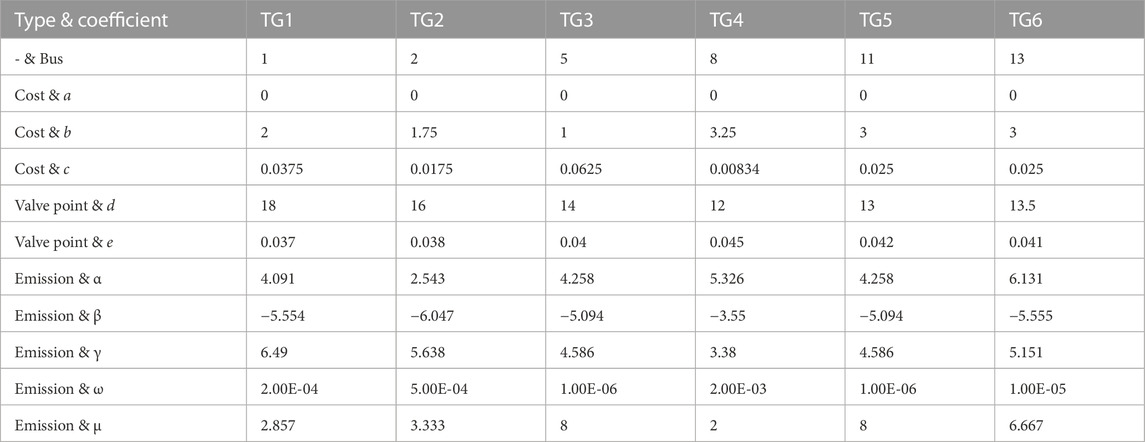
TABLE 3. Thermal generators’ cost and emission coefficients for the IEEE testing system having 30 buses.
5.1.1 Case 1: generation cost minimization
In the proposed work, we solve the OPF problems using the basic quadratic cost minimization function, as presented in Eq. 5. Simulations are performed for JAYA, BSA, and HJBSA algorithms. The resulted values of the total generation cost and optimal adjustment of control variables along with the remaining parameters are presented in Table 4. The algorithms’ results are obtained and compared based on the computational time and cost. HJBSA’s fuel cost is 860.54 $/h, JAYA’s fuel cost is 862.31 $/h, and BSA’s fuel cost is 900.01 $/h. The average computational time calculated in the proposed scenario for HJBSA is 6.783 s, for JAYA is 9.995, s and for BSA is 7.825 s. JAYA is the algorithm that only requires control parameters and no algorithm-specific parameters. This thing enhances JAYA’s effectiveness as compared to BSA. On the other hand, BSA might get trapped into the local minima and provide premature convergence. To overcome this risk, HJBSA is proposed. The obtained results prove the supremacy of the hybrid algorithm over JAYA and BSA due to less computational time and reduced generation cost.
5.1.2 Case 2: fuel cost minimization while the effect of the valve point load is considered
In Case 2, the sinusoidal term is added to the basic cost function. The effect of valve point load on the generation sources is considered for better reflection of the actual cost curve to have more realistic results (Chen et al., 2017). The objective function for Case 2 is considered to be non-linear, as given in Eq. 7. Simulations are performed for HJBSA, JAYA, and BSA algorithms while incorporating the effect of valve point load. Table 5 comprises the obtained results. The cost coefficients used to calculate the effect of valve point load are mentioned in Table 3. The fuel cost for all the three algorithms is increased up to a certain level as compared to the base case. However, HJBSA outperforms JAYA and BSA in terms of generation cost. The fuel cost for HJBSA with the addition of the valve point loading effect is increased up to 883.72 $/h, while the fuel cost of JAYA and BSA is 890.24 $/h and 929.21 $/h, respectively.
5.1.3 Case 3: reduction in carbon emission
Due to the emerging concerns related to the environment, this case focuses on the reduction of carbon emissions by imposing a carbon tax on the amount of gases emitted from thermal generators. The total fuel cost including the carbon tax is calculated using Eq. 8. The carbon tax rate used in the study presented is estimated to be $20 per ton. Table 6 shows the outcomes that were attained. The HJBSA algorithm outperforms JAYA and BSA in terms of emission reduction while still meeting the aforementioned system restrictions, as can be deduced from the table.
5.1.4 Case 4: reduction in power losses
In any transmission network, power loss is one of the major issues. To control the active power loss, an objective function is used, given in Eq. 10. The optimal values obtained while incorporating the power loss objective function are tabulated in Table 5. The total power loss is reduced up to 9.542 MW when the OPF problem is solved for HJBSA, 10.102 MW for JAYA, and 11.427 MW for BSA. From the simulation results’ comparison, it is observed that HJBSA has the minimum power loss. On the contrary, the JAYA algorithm has the maximum power loss.
5.1.5 Case 5: improvement of the voltage profile
The increase in bus voltage is one of the key factors in OPF. The voltage profile values may go over the specified thresholds when solely cost- or emission-based objectives are taken into account. Using Eq. (11), the techniques are applied to the IEEE 30-bus test case. Bus voltage operating levels are “kept in between” 0.94 p.u. and 1.06 p.u. Additionally, the suggested aim function for the cost of gasoline is minimized. Figure 3 shows the profile of voltage utilizing HJBSA, JAYA, and BSA. The total voltage deviation for HJBSA is observed to be 0.9056 p.u., for JAYA to be 0.9840 p.u., and for BSA to be 0.9846 p.u. Hence, all of the applied algorithms significantly improve the voltage profile.
5.2 IEEE 57-bus test case
A simple American power network was represented by the standard 57-bus IEEE testing system in the early 1960s (Illinois Center for a Smarter Electric Grid ICSEG, 2023). A huge power system that consists of 57 buses is used to verify the algorithms’ scalabilities. There are more number of control parameters for the testing system having 57 buses as compared to the system having 30 buses. The standard IEEE system having 57 buses comprises seven generators and 80 transmission lines at different bus locations, i.e., 1, 2, 3, 6, 8, 9, and 12. In the proposed work, we consider shunt reactive power sources at buses 53, 25, and 18. Moreover, 336.4 MVAR and 1250.8 MW are the total load demands for the energy system. The maximum and minimum limits, cost coefficients, line data, and bus data on actual energy generated are given in Banerjee et al. (2022). The single line structure for IEEE 57-bus is shown in Figure 4 (Power, 2023). The bus voltages are constrained between 0.98 p.u. and 1.04 p.u. for generator and load buses, respectively. System characteristics for the IEEE testing system having 57 buses are mentioned in Table 7. In order to get the optimized results for the 57-bus test system, three of the mentioned algorithms are applied and the corresponding values are observed.
5.2.1 Case 6: generation cost minimization
The OPF problems are solved using the standard IEEE system having 57 buses for Eq. 5. Cost coefficients utilized for the implementation of the proposed model are presented in Table 8. The simulation results for HJBSA, JAYA, and BSA are mentioned in Table 9, representing the optimized values for cost, emission, and control variables. The results for the algorithms are compared, and it is found that the total fuel cost obtained for HJBSA is 5506.9 $/h, for JAYA is 6237.4 $/h, and for BSA is 7245.6 $/h. By the obtained results, it is shown that the implemented algorithms provide more variations in the obtained cost. This depicts that in large power systems, these algorithms provide more realistic results with considerable amount of cost savings.
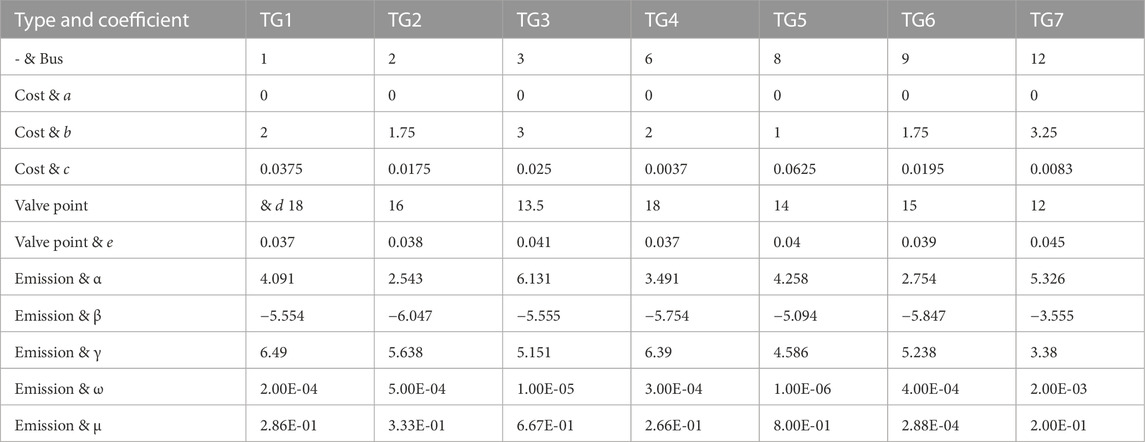
TABLE 8. Thermal generators’ cost and emission coefficients for the IEEE testing system having 57 buses.
5.2.2 Case 7: fuel cost minimization while the effect of valve point load is considered
The effect of adding the sine function in the basic fuel cost objective function for the valve point load is observed in Case 7. The cost coefficients used for calculating the effect of valve point load are mentioned in Table 8. Simulations are performed while incorporating the effect of valve point load, and the minimum fuel cost is obtained by HJBSA, i.e., 5568.6 $/h, while for JAYA and BSA, the fuel cost is 8187.2 $/h and 7682.2 $/h, respectively.
5.2.3 Case 8: reduction in carbon emission
To control the carbon emissions, a carbon tax is imposed upon emitted harmful gases. The amount of tax is included in the basic cost function, as mentioned in Eq. 8. The carbon tax rate in this scenario is considered to be $20/ton. The obtained results are displayed in Table 10. The HJBSA algorithm shows better results in terms of emission reduction as compared to BSA while fulfilling the mentioned system constraints. The total cost along with carbon tax for HJBSA is 6031.9 $/h, for JAYA is 6777.6 $/h, and for BSA is 7836.9 $/h.
5.2.4 Case 9: reduction in power losses
Power loss is minimized using Eq. 10, as discussed in Case 4. The values obtained while incorporating the power loss objective function are tabulated in Table 11. The power loss value obtained for HJBSA is 13.473 MW, for JAYA is 20.552 MW, and for BSA is 18.638 MW.
5.2.5 Case 10: voltage profile improvement
The constraints of the voltage bus are considered vital when solving the OPF problems. It is because the operating voltage values are sometimes found to be very close to the given thresholds. Therefore, the voltage bus-operating values are kept within the range of 0.98 p.u. and 1.04 p.u.. Figure 5 shows the individual voltage profiles for three different schemes, JAYA, BSA, and HJBSA, with respect to the IEEE 57-bus testing system. All schemes exhibit similar behavior with a slight voltage deviation, which depicts the performance of each scheme. It is observed that the voltage deviation for HJBSA is 0.5250 p.u., for JAYA is 0.9904 p.u., and for BSA is 0.9837 p.u..
6 Conclusion and future work
The applications of the innovative population-based algorithms BSA, JAYA, and the suggested hybrid HJBSA for addressing OPF issues are shown in the paper under consideration. The resilience assessment is performed in the proposed work. Optimization and evaluation of five diversified objective functions are carried out for both IEEE 30- and 57-bus systems while keeping in view the mentioned system constraints. From the comparison results, HJBSA proves to be more efficient and robust as compared to JAYA and BSA in terms of minimization of fuel cost and power loss, and reduction in carbon emissions. Moreover, it is observed and concluded that these implemented methods provide more realistic and effective results when dealing with large-scale power systems. In the future, the standard bus test systems can be modified with the integration of RERs to further minimize both the fuel cost and the carbon emissions. In addition, hybridization of the proposed algorithms to enhance optimization capability, controlling the fast convergence of JAYA, and the use of fuzzy techniques can be studied.
Data availability statement
The original contributions presented in the study are included in the article/Supplementary Material. Further inquiries can be directed to the corresponding author.
Author contributions
All authors listed have made a substantial, direct, and intellectual contribution to the work and approved it for publication.
Funding
This Research is funded by Researchers Supporting Project Number (RSPD2023R947), King Saud University, Riyadh, Saudi Arabia.
Conflict of interest
The authors declare that the research was conducted in the absence of any commercial or financial relationships that could be construed as a potential conflict of interest.
Publisher’s note
All claims expressed in this article are solely those of the authors and do not necessarily represent those of their affiliated organizations, or those of the publisher, the editors, and the reviewers. Any product that may be evaluated in this article, or claim that may be made by its manufacturer, is not guaranteed or endorsed by the publisher.
References
Abaci, K., and Yamacli, V. (2016). Differential search algorithm for solving multi-objective optimal power flow problem. Int. J. Electr. Power & Energy Syst. 79, 1–10. doi:10.1016/j.ijepes.2015.12.021
Abd El-sattar, S., Kamel, S., Ebeed, M., and Jurado, F. (2021). An improved version of salp swarm algorithm for solving optimal power flow problem. Soft Comput. 25 (5), 4027–4052. doi:10.1007/s00500-020-05431-4
Akbari, E., Ghasemi, M., Gil, M., Rahimnejad, A., and Andrew Gadsden, S. (2021). Optimal power flow via teaching-learning-studying-based optimization algorithm. Electr. Power Components Syst. 49, 584–601. doi:10.1080/15325008.2021.1971331
Banerjee, S., Banerjee, D., Roy, P. K., Kumar, A. P., Justin, A., and Ramanathan, M. (2022). Structural dynamics and catalytic modulations of Aβ regulating enzymes as future outlook for Alzheimer's. Int. J. Appl. Metaheuristic Comput. (IJAMC) 13 (1), 1–8. doi:10.1016/j.bbrc.2022.09.068
Biswas, P. P., Suganthan, P. N., Mallipeddi, R., and Amaratunga, G. A. (2019). Optimal reactive power dispatch with uncertainties in load demand and renewable energy sources adopting scenario-based approach. Appl. Soft Comput. 75, 616–632. doi:10.1016/j.asoc.2018.11.042
Bouchekara, H. R. E. H., Chaib, A. E., Abido, M. A., and El-Sehiemy, R. A. (2016). Optimal power flow using an improved colliding bodies optimization algorithm. Appl. Soft Comput. 42, 119–131. doi:10.1016/j.asoc.2016.01.041
Castro, L. M., Ramírez-Ramos, C., Sánchez, J. H., and Guillén, D. (2022). On the modelling of DC microgrids for steady-state power flow studies. Electr. Power Syst. Res. 207, 107868. doi:10.1016/j.epsr.2022.107868
Chen, G., Qian, J., Zhang, Z., and Li, S. (2020). Application of modified pigeon-inspired optimization algorithm and constraint-objective sorting rule on multi-objective optimal power flow problem. Appl. Soft Comput. 92, 106321. doi:10.1016/j.asoc.2020.106321
Chen, G., Qian, J., Zhang, Z., and Sun, Z. (2019). Applications of novel hybrid bat algorithm with constrained Pareto fuzzy dominant rule on multi-objective optimal power flow problems. IEEE Access 7, 52060–52084. doi:10.1109/access.2019.2912643
Chen, G., Qiu, S., Zhang, Z., Sun, Z., and Liao, H. (2017). Optimal power flow using gbest-guided cuckoo search algorithm with feedback control strategy and constraint domination rule. Math. Problems Eng. 2017, 1–14. doi:10.1155/2017/9067520
Chen, Z., Guo, W., Zhao, R., Liu, Y., and Xie, H. (2022). Deep learning optimization of microgrid economic dispatch and wireless power transmission using blockchain. Wirel. Commun. Mob. Comput. 2022, 1–13. doi:10.1155/2022/2050031
Chopra, N., Brar, Y. S., and Dhillon, J. S. (2021). “An improved simplex based particle swarm optimization for environmentally constrained economic dispatch problem in thermal power plants,” in Innovations in electrical and electronic engineering (Singapore: Springer), 1–17.
Daryani, N., Hagh, M. T., and Teimourzadeh, S. (2016). Adaptive group search optimization algorithm for multi-objective optimal power flow problem. Appl. Soft Comput. 38, 1012–1024. doi:10.1016/j.asoc.2015.10.057
Deng, J., Wu, G., Wang, Y., Su, Y., and Liu, A. (2023). Security-constrained hybrid optimal energy flow model of multi-energy system considering N-1 component failure. J. Energy Storage 64, 107060. doi:10.1016/j.est.2023.107060
Ebeed, M., Kamel, S., and Jurado, F. (2018). “Optimal power flow using recent optimization techniques,” in Classical and recent aspects of power system optimization (Academic Press), 157–183.
El-Fergany, A. A., and Hasanien, H. M. (2020). Salp swarm optimizer to solve optimal power flow comprising voltage stability analysis. Neural Comput. Appl. 32 (9), 5267–5283. doi:10.1007/s00521-019-04029-8
El-Fergany, A. A., and Hasanien, H. M. (2015). Single and multi-objective optimal power flow using grey wolf optimizer and differential evolution algorithms. Electr. Power Components Syst. 43 (13), 1548–1559. doi:10.1080/15325008.2015.1041625
El-Fergany, A. A., and Hasanien, H. M. (2018). Tree-seed algorithm for solving optimal power flow problem in large-scale power systems incorporating validations and comparisons. Appl. Soft Comput. 64, 307–316. doi:10.1016/j.asoc.2017.12.026
Electrical Engineering (2023). Electrical engineering. University of Washington. Available at: https://www2.ee.washington.edu/research/pstca/pf30/pg_tca30bus.htm (Accessed January 4th, 2023).
Hafeez, G., Javaid, N., Iqbal, S., and Khan, F. A. (2018). Optimal residential load scheduling under utility and rooftop photovoltaic units. Energies 11 (3), 611–638. doi:10.3390/en11030611
He, X., Wang, W., Jiang, J., and Xu, L. (2015). An improved artificial bee colony algorithm and its application to multi-objective optimal power flow. Energies 8 (4), 2412–2437. doi:10.3390/en8042412
Hussain, H. M., Javaid, N., Iqbal, S., Hasan, Q. U., Aurangzeb, K., and Alhussein, M. (2018). An efficient demand side management system with a new optimized home energy management controller in smart grid. Energies 11 (1), 190–218. doi:10.3390/en11010190
Illinois Center for a Smarter Electric Grid (ICSEG) (2023). Illinois center for a smarter electric grid (ICSEG). Available at: http://icseg.iti.illinois.edu/ieee-57-bus-system/. (Accessed January 18, 2023).
Iqbal, Z., Javaid, N., Iqbal, S., Aslam, S., Khan, Z. A., Abdul, W., et al. (2018). A domestic microgrid with optimized home energy management system. Energies 11 (4), 1002–1041. doi:10.3390/en11041002
Javaid, N., Ahmed, F., Ullah, I., Abid, S., Abdul, W., Alamri, A., et al. (2017b). Towards cost and comfort based hybrid optimization for residential load scheduling in a smart grid. Energies 10 (10), 1546–1573. doi:10.3390/en10101546
Javaid, N., Ullah, I., Akbar, M., Iqbal, Z., Khan, F. A., Alrajeh, N., et al. (2017a). An intelligent load management system with renewable energy integration for smart homes. IEEE Access 5, 13587–13600. doi:10.1109/access.2017.2715225
Kaur, M., and Narang, N. (2023). “Optimal power flow solution using space transformational invasive weed optimization algorithm,” in Iranian journal of science and Technology, transactions of electrical engineering, 1–27. doi:10.1007/s40998-023-00592-y
Khalid, A., Javaid, N., Guizani, M., Alhussein, M., Aurangzeb, K., and Ilahi, M. (2018). Towards dynamic coordination among home appliances using multi-objective energy optimization for demand side management in smart buildings. IEEE Access 6, 19509–19529. doi:10.1109/access.2018.2791546
Khan, A., Hizam, H., bin Abdul Wahab, N. I., and Lutfi Othman, M. (2020). Optimal power flow using hybrid firefly and particle swarm optimization algorithm. Plos one 15 (8), e0235668. doi:10.1371/journal.pone.0235668
Li, S., Gong, W., Wang, L., Yan, X., and Hu, C. (2020). Optimal power flow by means of improved adaptive differential evolution. Energy 198, 117314. doi:10.1016/j.energy.2020.117314
Liu, Y., Ćetenović, D., Li, H., Gryazina, E., and Terzija, V. (2022). An optimized multi-objective reactive power dispatch strategy based on improved genetic algorithm for wind power integrated systems. Int. J. Electr. Power & Energy Syst. 136, 107764. doi:10.1016/j.ijepes.2021.107764
Mallala, B., and Dwivedi, D. (2022). Salp swarm algorithm for solving optimal power flow problem with thyristor-controlled series capacitor. J. Electron. Sci. Technol. 20 (2), 100156. doi:10.1016/j.jnlest.2022.100156
Meng, X. B., Gao, X. Z., Lu, L., Liu, Y., and Zhang, H. (2016). A new bio-inspired optimisation algorithm: Bird Swarm Algorithm. J. Exp. Theor. Artif. Intell. 28 (4), 673–687. doi:10.1080/0952813x.2015.1042530
Mohagheghi, E., Gabash, A., Alramlawi, M., and Li, P. (2018). Real-time optimal power flow with reactive power dispatch of wind stations using a reconciliation algorithm. Renew. Energy 126, 509–523. doi:10.1016/j.renene.2018.03.072
Mohamed, A. A. A., Mohamed, Y. S., El-Gaafary, A. A., and Hemeida, A. M. (2017). Optimal power flow using moth swarm algorithm. Electr. Power Syst. Res. 142, 190–206. doi:10.1016/j.epsr.2016.09.025
Optimal Power Flow— NEOS (2022). Optimal power flow— NEOS. Available at: https://neos-guide.org/content/optimal-power-flow. (Accessed January 23th, 2022).
Pandya, S. B., Ravichandran, S., Manoharan, P., Jangir, P., and Alhelou, H. H. (2022). Multi-objective optimization framework for optimal power flow problem of hybrid power systems considering security constraints. IEEE Access 10, 103509–103528. doi:10.1109/access.2022.3209996
Power (2023). Power. Available at: http://al-roomi.org/power-flow/57-bus-system. (Accessed January 17, 2023).
Pravina, P., Babu, M. R., and Kumar, A. R. (2021). Solving optimal power flow problems using adaptive quasi-oppositional differential migrated biogeography-based optimization. J. Electr. Eng. Technol. 16, 1891–1903. doi:10.1007/s42835-021-00739-z
Premkumar, M., Jangir, P., Sowmya, R., and Elavarasan, R. M. (2021). Many-objective gradient-based optimizer to solve optimal power flow problems: Analysis and validations. Eng. Appl. Artif. Intell. 106, 104479. doi:10.1016/j.engappai.2021.104479
Premkumar, M., Kumar, C., Dharma Raj, T., Sundarsingh Jebaseelan, S. D. T., Jangir, P., and Haes Alhelou, H. (2023). “A reliable optimization framework using ensembled successive history adaptive differential evolutionary algorithm for optimal power flow problems,” in IET generation (Transmission & Distribution).
Pulluri, H., Naresh, R., and Sharma, V. (2017). An enhanced self-adaptive differential evolution based solution methodology for multiobjective optimal power flow. Appl. Soft Comput. 54, 229–245. doi:10.1016/j.asoc.2017.01.030
Ramesh, S., Verdú, E., Karunanithi, K., Raja, S. P., and S P, R. (2023). An optimal power flow solution to deregulated electricity power market using meta-heuristic algorithms considering load congestion environment. Electr. Power Syst. Res. 214, 108867. doi:10.1016/j.epsr.2022.108867
Rao, R. (2016). Jaya: A simple and new optimization algorithm for solving constrained and unconstrained optimization problems. Int. J. Industrial Eng. Comput. 7 (1), 19–34. doi:10.5267/j.ijiec.2015.8.004
Reddy, S. S. (2017). Optimal scheduling of thermal-wind-solar power system with storage. Renew. Energy 101, 1357–1368. doi:10.1016/j.renene.2016.10.022
Safaie, A. A., Bidgoli, M. A., and Javadi, S. (2022). A multi-objective optimization framework for integrated electricity and natural gas networks considering smart homes in downward under uncertainties. Energy 239, 122214. doi:10.1016/j.energy.2021.122214
Shafiq, S., Javaid, N., and Aslam, S. (2018). “Optimal power flow control in a smart micro-grid using bird swarm algorithm,” in 5th international multi-topic ICT conference (Jamshoro, Pakistan (IMTIC). held on 25-27 April.
Shaheen, M. A., Ullah, Z., Qais, M. H., Hasanien, H. M., Chua, K. J., Tostado-Véliz, M., et al. (2022). Solution of probabilistic optimal power flow incorporating renewable energy uncertainty using a novel circle search algorithm. Energies 15 (21), 8303. doi:10.3390/en15218303
Shargh, S., Mohammadi-ivatloo, B., Seyedi, H., and Abapour, M. (2016). Probabilistic multi-objective optimal power flow considering correlated wind power and load uncertainties. Renew. Energy 94, 10–21. doi:10.1016/j.renene.2016.02.064
Shehab, M., Abualigah, L., Al Hamad, H., Alabool, H., Alshinwan, M., and Khasawneh, A. M., 2020. Moth–flame optimization algorithm: Variants and applications. Neural Comput. Appl., 32(14), 1286731–1289884. Buch, H., Trivedi, I.N. and Jangir, P., 2017. Moth flame optimization to solve optimal power flow with non-parametric statistical evaluation validation. Cogent Engineering, 4, pp.1-22, 10.1080/23311916.2017.1286731. doi:10.1007/s00521-019-04570-6
Shilaja, C., and Arunprasath, T. (2019). Optimal power flow using moth swarm algorithm with gravitational search algorithm considering wind power. Future Gener. Comput. Syst. 98, 708–715. doi:10.1016/j.future.2018.12.046
Skolfield, J. K., and Escobedo, A. R. (2021). Operations research in optimal power flow: A guide to recent and emerging methodologies and applications. Eur. J. Operational Res. 300, 387–404. doi:10.1016/j.ejor.2021.10.003
Wang, M., and Abdalla, M. A. A. (2022). Optimal energy scheduling based on jaya algorithm for integration of vehicle-to-home and energy storage system with photovoltaic generation in smart home. Sensors 22 (4), 1306. doi:10.3390/s22041306
Warid, W., Hizam, H., Mariun, N., and Abdul-Wahab, N. I. (2016). Optimal power flow using the jaya algorithm. Energies 9 (9), 678–696. doi:10.3390/en9090678
Warid, W., Hizam, H., Mariun, N., and Wahab, N. I. A. (2018). A novel quasi-oppositional modified Jaya algorithm for multi-objective optimal power flow solution. Appl. Soft Comput. 65, 360–373. doi:10.1016/j.asoc.2018.01.039
Keywords: bird swarm optimization, carbon emission, IEEE bus systems, JAYA, optimal power flow
Citation: Aurangzeb K, Shafiq S, Alhussein M, Pamir , Javaid N and Imran M (2023) An effective solution to the optimal power flow problem using meta-heuristic algorithms. Front. Energy Res. 11:1170570. doi: 10.3389/fenrg.2023.1170570
Received: 21 February 2023; Accepted: 21 July 2023;
Published: 25 September 2023.
Edited by:
Yogendra Arya, J.C. Bose University of Science and Technology, YMCA, IndiaReviewed by:
Milan Joshi, University of New Mexico, United StatesMartin P. Calasan, University of Montenegro, Montenegro
Alpamis Kutlimuratov, Gachon University, Republic of Korea
Sundaram Pandya, Gujarat Technological University, India
Mohit Bajaj, Graphic Era University, India
Copyright © 2023 Aurangzeb, Shafiq, Alhussein, Pamir, Javaid and Imran. This is an open-access article distributed under the terms of the Creative Commons Attribution License (CC BY). The use, distribution or reproduction in other forums is permitted, provided the original author(s) and the copyright owner(s) are credited and that the original publication in this journal is cited, in accordance with accepted academic practice. No use, distribution or reproduction is permitted which does not comply with these terms.
*Correspondence: Nadeem Javaid, bmFkZWVtamF2YWlkcWF1QGdtYWlsLmNvbQ==; Khursheed Aurangzeb, a2F1cmFuZ3plYkBrc3UuZWR1LnNh
†These authors have contributed equally to this work
 Khursheed Aurangzeb
Khursheed Aurangzeb Sundas Shafiq2†
Sundas Shafiq2† Nadeem Javaid
Nadeem Javaid Muhammad Imran
Muhammad Imran